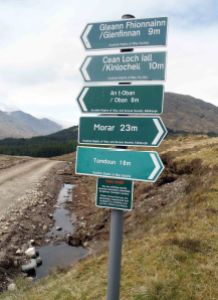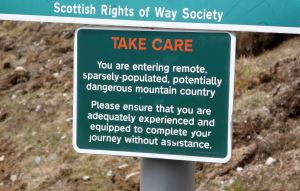In one of my previous posts http://johndburns.wordpress.com/2014/01/15/true-north/ I made some comments at the expense of Scotways previously known as the Scottish Rights of Way Society. The feature was subsequently published in the Mountain Bothies Association (MBA) newsletter including my rather uncomplimentary assertions about Scotways signage. Understandably Scotways objected to my comments and received an apology from the MBA.
There is a serious point to my blog and I stand by my views about the signs. One of the signs I object to is this one at the head of Loch Arkaig. I’m sure Scotways do a lot of good work and are well intentioned but I do not see the point of this sign and feel it is more of a blot on the landscape.

What is the point of this sign? If you are a competent hill goer you won’t need its warning and if you are not you won’t understand it. The sign points vaguely in the direction of various places. Should you need to follow signs like these what happens when you find yourself beyond the sign in places where there are no waymarks?

I understand that Scotways is a charity and I don’t want to undermine them as a body but surely there are differing opinions here and we have a right to debate the placing of such signs in our landscape. I should perhaps point out that these are my views and in no way reflect the views of the MBA. Perhaps Scotways should think again about its use of signage in remote and beautiful places. As we all know the road to hell is paved with good intentions, it may well also be signposted by Scotways.
What do other folk feel about these signs?
https://www.edfringe.com/whats-on/theatre/mallory-beyond-everest
I think you’re exactly right: the initial signs certainly would imply that there will be additional ones further down the track, which pretty much negates the message of the (much smaller) warning.
Those are certainly my thoughts. I’m the intention is to assist access but I don’t see that it does. I just wonder who these signs are for.
I think you’re exactly right: the initial signs certainly would imply that there will be additional ones further down the track, which pretty much negates the message of the (much smaller) warning.
Those are certainly my thoughts. I’m the intention is to assist access but I don’t see that it does. I just wonder who these signs are for.
I don’t know – I think I prefer the signs to be there. Usually, I’m pretty sure I’m setting off down the right track but it’s nice to be sure. And sometimes, the track sets off unobtrusively and the sign makes an unobvious start more visible. The look of them doesn’t really bother me either but then I’m not someone who bothers about man-made structures in the main – I know I’m very much in the minority there. If I do, I find the most intrusive things in the landscale are yuppie-type houses, such as in our greenbelt areas here, and roads with their noise and fumes…
I don’t know – I think I prefer the signs to be there. Usually, I’m pretty sure I’m setting off down the right track but it’s nice to be sure. And sometimes, the track sets off unobtrusively and the sign makes an unobvious start more visible. The look of them doesn’t really bother me either but then I’m not someone who bothers about man-made structures in the main – I know I’m very much in the minority there. If I do, I find the most intrusive things in the landscale are yuppie-type houses, such as in our greenbelt areas here, and roads with their noise and fumes…
When cycling in North Holland, I found myself in the most extensively waymarked and signed area that I have ever been in outside a town. The signs were well designed and unobtrusive but clearly visible. They also correlated to a useful map. Although I am an excellent map reader, I welcomed these sings in an unfamiliar area.
I might be glad of a helpful sign or two in the highlands too. Is it the design you don’t like? Or having any help for others less confident than yourself? I agree however on the warning sign. It is redundant.
When cycling in North Holland, I found myself in the most extensively waymarked and signed area that I have ever been in outside a town. The signs were well designed and unobtrusive but clearly visible. They also correlated to a useful map. Although I am an excellent map reader, I welcomed these sings in an unfamiliar area.
I might be glad of a helpful sign or two in the highlands too. Is it the design you don’t like? Or having any help for others less confident than yourself? I agree however on the warning sign. It is redundant.
Hi, it’s not the design it’s the fact that if you can’t navigate and follow the sign some of the places indicated are over 10 miles away so there would be many twists and turns to negotiate in places where there are no signs. So, in effect, the signs are useless unless you signpost the whole route.
Hi, it’s not the design it’s the fact that if you can’t navigate and follow the sign some of the places indicated are over 10 miles away so there would be many twists and turns to negotiate in places where there are no signs. So, in effect, the signs are useless unless you signpost the whole route.
This is an interesting topic for a debate, John. Once you erect one sign, you are duty bound to erect others. The warning sign is the sort of nonsense that affects our lives and is a sop to the litigious society in which we live. One could argue that a sign showing directions and times or distances is a good thing, but it is only a good thing if the policy is seen through with subsequent waymarkers. The absence of subsequent waymarkers might in itself be grounds for litigation in the event of an accident or other incident. Once you start….. In the European Alps signage is almost exclusively in yellow, and much of it is in the form of shaped and coloured waymarks on rock or wood (not possible of course in moorland areas). Their system aids safe travel and I would not want to be without it. Rarely have I felt lost walking out there. Frequently in the UK, I have struggled to make sense of paths that bear no correlation to what is on the map.
This is an interesting topic for a debate, John. Once you erect one sign, you are duty bound to erect others. The warning sign is the sort of nonsense that affects our lives and is a sop to the litigious society in which we live. One could argue that a sign showing directions and times or distances is a good thing, but it is only a good thing if the policy is seen through with subsequent waymarkers. The absence of subsequent waymarkers might in itself be grounds for litigation in the event of an accident or other incident. Once you start….. In the European Alps signage is almost exclusively in yellow, and much of it is in the form of shaped and coloured waymarks on rock or wood (not possible of course in moorland areas). Their system aids safe travel and I would not want to be without it. Rarely have I felt lost walking out there. Frequently in the UK, I have struggled to make sense of paths that bear no correlation to what is on the map.
I agree entirely, I like the Alpine system too. You either signpost the whole route or not at all.
I agree entirely, I like the Alpine system too. You either signpost the whole route or not at all.